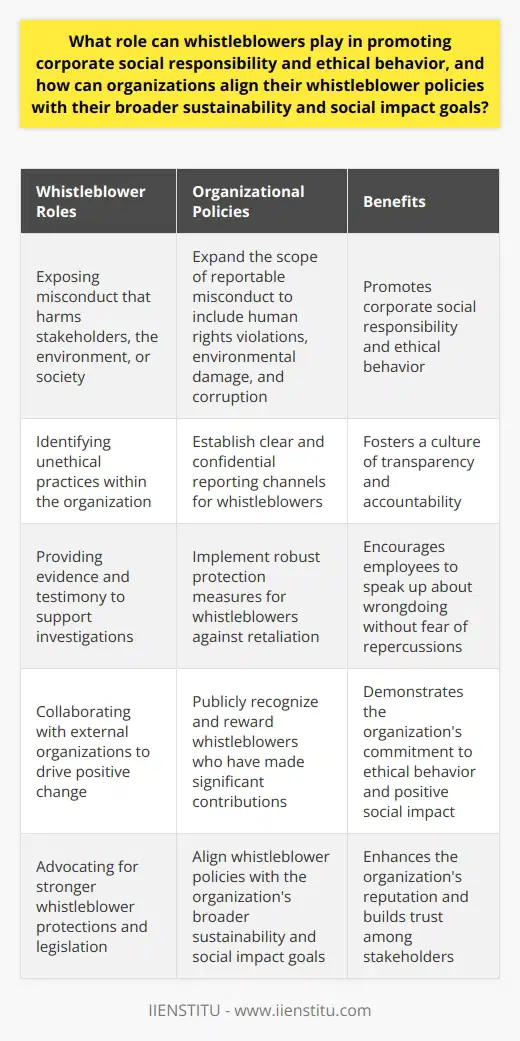
In today's complex business landscape, whistleblowing procedures have become an indispensable component of effective corporate governance. A well-crafted whistleblower policy not only safeguards the interests of employees who courageously speak out against wrongdoing but also fortifies the ethical foundation of the organization itself. As someone who has witnessed firsthand the consequences of inadequate whistleblower protections, I cannot overemphasize the significance of implementing a comprehensive and enforceable policy.
When I think back to my early days in the nonprofit sector, I recall an incident that left an indelible mark on my perception of organizational integrity. I had just started working at a prominent charity when I stumbled upon evidence of financial impropriety. Despite my initial hesitation, I mustered the courage to report my findings through the proper channels, only to find myself facing subtle but unmistakable retaliation from my superiors. It was a harrowing experience that taught me the vital importance of robust whistleblower protections.
The Key Elements of an Effective Whistleblower Policy

A whistleblower policy must be more than a mere formality; it should be a living, breathing document that permeates every level of the organization. Based on my experience and extensive research, I believe that an effective policy should encompass the following critical elements:
Clear definition of reportable misconduct: Employees must have a clear understanding of what constitutes wrongdoing within the scope of the policy. This includes not only illegal activities but also unethical practices that violate the organization's code of conduct.
Multiple reporting channels: The policy should provide various avenues for reporting, including anonymous hotlines, designated email addresses, and in-person reporting to trusted individuals within the organization. Having multiple options empowers employees to choose the method that feels most comfortable and secure for them.
Strict confidentiality measures: Maintaining the confidentiality of the whistleblower's identity is paramount. The policy must outline specific measures to protect the whistleblower's anonymity throughout the investigation process.
Anti-retaliation provisions: The policy must explicitly prohibit any form of retaliation against whistleblowers, including demotion, harassment, or termination. It should also detail the consequences for those who engage in retaliatory behavior.
Thorough investigation procedures: The policy should establish clear protocols for investigating reported misconduct, including timelines, roles and responsibilities, and documentation requirements. Investigations must be conducted promptly, objectively, and with the utmost professionalism.
Fostering a Culture of Integrity
Implementing a robust whistleblower policy is only the first step; the real challenge lies in cultivating a culture that encourages and supports ethical behavior. In my experience, this requires a multi-faceted approach that includes:
Regular training and awareness programs: Employees at all levels should receive comprehensive training on the whistleblower policy, including how to identify and report misconduct. These training sessions should be engaging, interactive, and tailored to the specific needs of each department.
Leadership commitment: Senior management must lead by example, demonstrating an unwavering commitment to ethical conduct and supporting whistleblowers who come forward. When leaders walk the talk, it sends a powerful message throughout the organization.
Positive reinforcement: Organizations should recognize and reward employees who uphold the highest standards of integrity. This can include public acknowledgment, bonuses, or other incentives that encourage ethical behavior.
The Benefits of a Strong Whistleblower Policy
Investing in a comprehensive whistleblower policy yields numerous benefits for organizations, including:
Enhanced risk management: By providing a safe and confidential channel for reporting misconduct, organizations can identify and mitigate potential risks before they escalate into full-blown crises. Early detection is key to minimizing financial, legal, and reputational damage.
Improved employee morale: When employees feel empowered to speak up without fear of retaliation, it fosters a sense of trust and loyalty within the organization. This, in turn, leads to higher job satisfaction, lower turnover rates, and increased productivity.
Stronger stakeholder confidence: Organizations that demonstrate a commitment to transparency and accountability are more likely to earn the trust and support of investors, customers, and the general public. A robust whistleblower policy sends a clear message that the organization takes its ethical responsibilities seriously.
Navigating the Challenges of Whistleblowing

Despite the clear benefits of a strong whistleblower policy, implementing one is not without its challenges. Some of the most common obstacles include:
Overcoming Cultural Barriers
In some organizations, there may be a deeply ingrained culture of silence or a fear of speaking out against wrongdoing. Employees may worry about being labeled as troublemakers or facing social ostracism from their colleagues. To overcome these barriers, organizations must actively promote a culture of openness and transparency, encouraging employees to voice their concerns without fear of reprisal.
Ensuring Confidentiality in the Digital Age
With the proliferation of digital communication channels, maintaining the confidentiality of whistleblowers has become increasingly complex. Organizations must invest in secure, encrypted reporting systems and establish strict protocols for handling sensitive information. Regular audits and penetration testing can help identify and address potential vulnerabilities in the system.
Balancing Transparency and Privacy
While transparency is essential for building trust and accountability, organizations must also respect the privacy rights of all parties involved in a whistleblowing incident. This includes protecting the identity of the whistleblower, as well as ensuring that the accused party has a fair opportunity to respond to the allegations. Striking the right balance requires careful planning and ongoing monitoring of the investigation process.
The Future of Whistleblowing

As organizations continue to navigate an increasingly complex and regulated business environment, the importance of effective whistleblowing procedures will only continue to grow. Here are some key trends and developments to watch:
The Rise of External Reporting Channels
In addition to internal reporting mechanisms, many organizations are now turning to external, third-party whistleblower hotlines to provide an added layer of independence and objectivity. These services offer 24/7 support, multi-lingual capabilities, and specialized expertise in handling sensitive reports. As the demand for external reporting channels grows, we can expect to see more innovation and standardization in this area.
Increased Legislative Protection for Whistleblowers
Governments around the world are recognizing the critical role that whistleblowers play in exposing corruption, fraud, and other forms of misconduct. In recent years, we have seen a wave of new legislation aimed at strengthening protections for whistleblowers, including the EU Whistleblower Protection Directive and the US Whistleblower Protection Act. As these laws continue to evolve, organizations will need to stay abreast of their legal obligations and adapt their policies accordingly.
The Impact of Artificial Intelligence
As artificial intelligence (AI) becomes more sophisticated, it has the potential to revolutionize the way organizations handle whistleblowing incidents. AI-powered tools can help identify patterns of misconduct, analyze large volumes of data, and even predict potential risks before they materialize. However, the use of AI in whistleblowing also raises important ethical questions around privacy, bias, and accountability that will need to be carefully addressed.
Conclusion
In conclusion, implementing a robust whistleblower policy is no longer a luxury but a necessity for any organization that values integrity, transparency, and accountability. By providing a safe and confidential channel for reporting misconduct, organizations can mitigate risks, foster a culture of trust, and demonstrate their commitment to ethical behavior.
However, creating an effective policy is only the first step; organizations must also invest in ongoing training, communication, and enforcement to ensure that the policy is truly embedded in the fabric of the organization. This requires leadership buy-in, employee engagement, and a willingness to confront uncomfortable truths.
As someone who has experienced firsthand the challenges and rewards of speaking truth to power, I urge all organizations to prioritize the development and implementation of a comprehensive whistleblower policy. It is not only the right thing to do but also a smart business decision that can help build long-term success and resilience.
So let us all work together to create a culture where every voice is heard, every concern is addressed, and every individual feels empowered to do the right thing. By doing so, we can build organizations that are not only profitable but also purposeful, not only compliant but also committed to the highest standards of integrity.
Frequently Asked Questions
What are the key components of a comprehensive whistleblower policy, and how can organizations ensure that these elements are effectively implemented and communicated to all employees?
A comprehensive whistleblower policy should include clear definitions of reportable misconduct, multiple reporting channels (including anonymous options), strict confidentiality measures, anti-retaliation provisions, and thorough investigation procedures. To ensure effective implementation, organizations should conduct regular training sessions, communicate the policy through various channels (e.g., employee handbooks, intranet, posters), and obtain signed acknowledgments from all employees. Leadership should also demonstrate a strong commitment to the policy and lead by example.
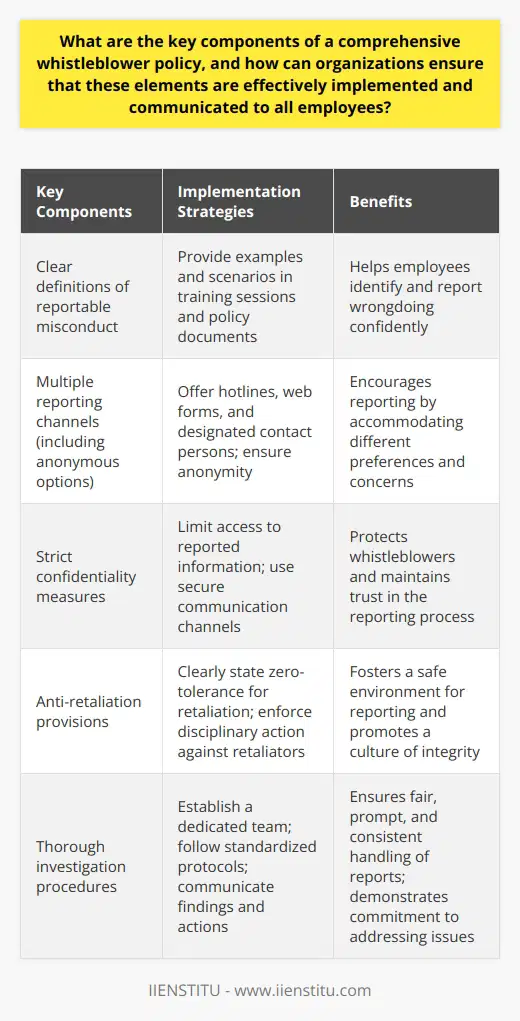
How can organizations strike a balance between encouraging whistleblowing and preventing false or malicious reports that can damage reputations and morale?
Organizations can prevent false or malicious reports by emphasizing the importance of honest and factual reporting in their training and communications. They can also implement penalties for knowingly making false reports, such as disciplinary action or termination of employment. However, it is crucial to strike a balance and not create a culture of fear that discourages legitimate reporting. Organizations should focus on creating a safe and supportive environment that encourages employees to come forward with concerns in good faith.
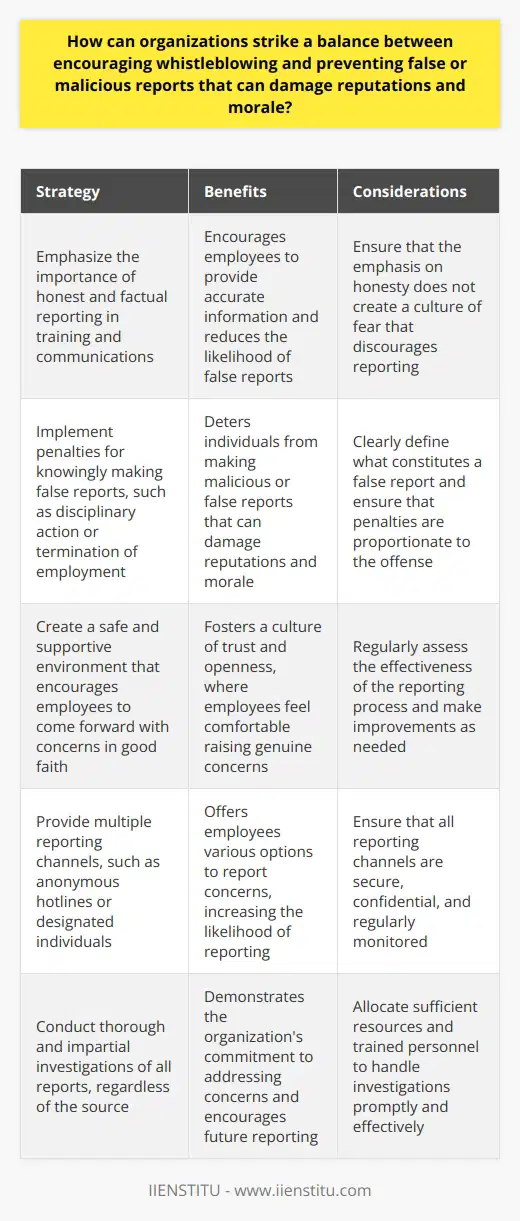
What role does organizational culture play in the effectiveness of whistleblower policies, and how can leaders foster an environment that encourages speaking up and values integrity?
Organizational culture plays a critical role in the effectiveness of whistleblower policies. Leaders must create a culture of transparency, trust, and accountability, where employees feel comfortable speaking up without fear of retaliation. This can be achieved through regular communication, training, and modeling of ethical behavior by leadership. Organizations should also celebrate and reward employees who demonstrate a commitment to integrity and ethical conduct.
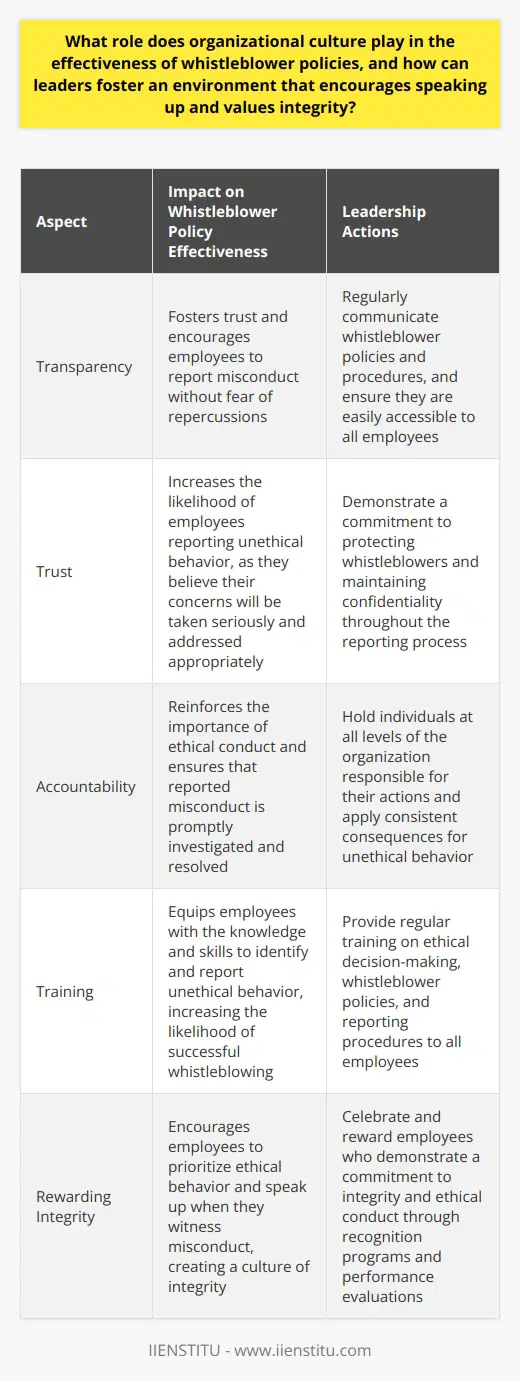
How can organizations protect whistleblowers from retaliation, particularly in cases where the accused party holds a position of power or influence within the company?
To protect whistleblowers from retaliation, organizations should have clear anti-retaliation provisions in their policies, specifying the consequences for those who engage in retaliatory behavior. They should also provide multiple reporting channels, including anonymous options, to allow whistleblowers to come forward without fear of being identified. In cases where the accused party holds a position of power, organizations may need to involve external investigators or legal counsel to ensure an impartial and objective investigation.

What are the legal and regulatory requirements for whistleblower policies, and how can organizations ensure compliance with these standards across different jurisdictions?
Legal and regulatory requirements for whistleblower policies vary by jurisdiction, but some common standards include the Sarbanes-Oxley Act (SOX) in the United States, the EU Whistleblower Protection Directive, and the ISO 37002 guidelines for whistleblowing management systems. Organizations should work with legal counsel to ensure compliance with applicable laws and regulations, and regularly review and update their policies to reflect any changes in legal or regulatory requirements.
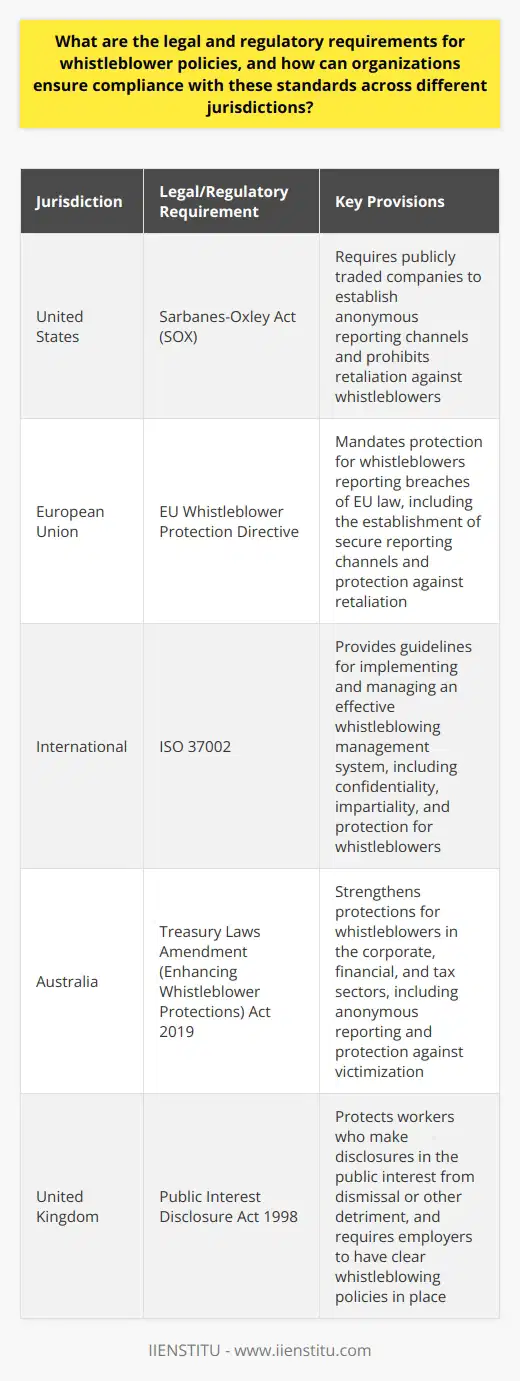
How can organizations leverage technology, such as secure reporting platforms and data analytics, to improve the efficiency and effectiveness of their whistleblower programs?
Technology can play a significant role in improving the efficiency and effectiveness of whistleblower programs. Secure reporting platforms can provide a confidential and anonymous channel for employees to report concerns, while data analytics tools can help identify patterns and trends in reported issues. Organizations can also leverage machine learning algorithms to flag potential risks and prioritize investigations based on the severity and urgency of the reported misconduct.

What are the potential risks and challenges associated with outsourcing whistleblower hotlines to third-party providers, and how can organizations mitigate these risks?
Outsourcing whistleblower hotlines to third-party providers can offer benefits such as 24/7 availability, multi-lingual support, and specialized expertise. However, it also poses risks such as data privacy concerns, lack of control over the investigation process, and potential conflicts of interest. To mitigate these risks, organizations should conduct thorough due diligence when selecting a provider, ensure that the provider has robust data security and confidentiality measures in place, and maintain clear communication and oversight throughout the investigation process.

How can organizations measure the success and impact of their whistleblower policies, and what metrics should they use to track progress over time?
Organizations can measure the success and impact of their whistleblower policies through a variety of metrics, such as the number of reports received, the percentage of reports that are substantiated, the average time to resolve investigations, and the level of employee satisfaction with the reporting process. They can also track the number of retaliation complaints and the outcomes of those complaints. Regular surveys and focus groups can provide valuable feedback on the effectiveness of the policy and identify areas for improvement.
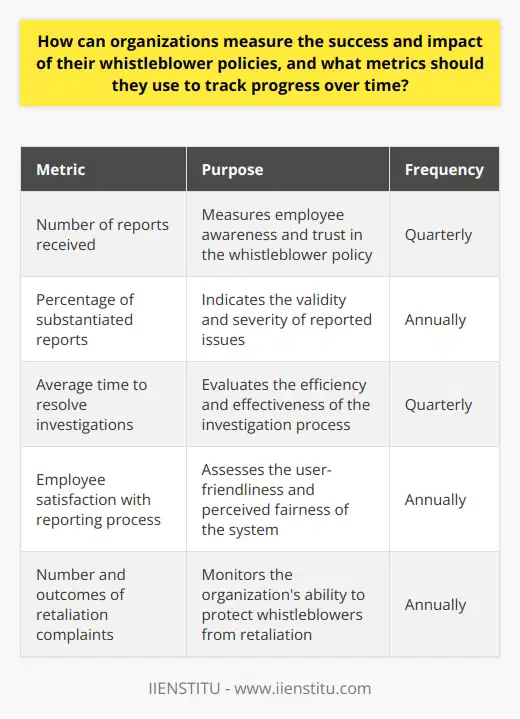
What role can whistleblowers play in promoting corporate social responsibility and ethical behavior, and how can organizations align their whistleblower policies with their broader sustainability and social impact goals?
Whistleblowers can play a crucial role in promoting corporate social responsibility and ethical behavior by exposing misconduct that may harm stakeholders, the environment, or society at large. Organizations can align their whistleblower policies with their broader sustainability and social impact goals by expanding the scope of reportable misconduct to include issues such as human rights violations, environmental damage, and corruption. They can also publicly recognize and reward whistleblowers who have made significant contributions to promoting ethical behavior and positive social change.
